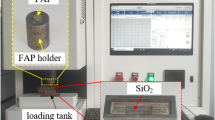Abstract
Self-conditioning performance of polishing pad is an important characteristic to influence processing efficiency and service life in chemical mechanical polishing (CMP). The slurry can react with the pad surface, which affects its self-conditioning performance in fixed abrasive polishing process. Wear ratio of wafer material removal rate (MRR) and pad wear rate is introduced to evaluate self-conditioning performance of fixed abrasive pad (FAP). To clear the effect of chemical additive on FAP self-conditioning, wear ratio, FAP surface topography, friction coefficient, and acoustic emission signal of polishing process were investigated in fixed abrasive polishing of quartz glass with ferric nitrate, ethylenediamine (EDA), and triethanolamine (TEA) slurry, respectively. Results indicate that TEA slurry can provide excellent self-conditioning of FAP in fixed abrasive polishing of quartz glass. MRR and wear ratio maintain high levels during the whole polishing process. Friction coefficient and acoustic emission signal are more stable than that of the other two chemical additives. An appropriate amount of TEA, which is beneficial to enhance MRR and extends service life of FAP, is added in the polishing slurry to improve FAP self-conditioning in fixed abrasive polishing process.
Similar content being viewed by others
References
Qiu Y, Gu ML, Wei FG, Wei Z (2014) Influence of tool inclination on micro-ball-and milling of quartz glass. Mater Manuf Process 29(11):1436–1440
Han RC, Wei XM, Zhuang Y, Sampurno YA, Philipossian A (2016) Method for accelerated diamond fracture characterization in chemical mechanical planarization. Microelectron Eng 149(1):37–40
Zhao Y, Zuo DW, Sun YL, Wang M (2015) Experimental study on multi-layer ice fixed abrasive polishing of single crystal germanium wafer. Int J Adv Manuf Technol. doi:10.1007/s00170-015-8020-3
Zhou P, Dong ZG, Kang R, Jin ZJ, Guo DM (2015) A mixed elastohydrodynamic lubrication model for simulation of chemical mechanical polishing with double-layer structure of polishing pad. Int J Adv Manuf Technol 77(1):107–116
Rao PK, Beyca OF, Kong Z, Bukkapatnam STS, Case KE, Komanduri R (2015) A graph theoretic approach for quantification of surface morphology and its application to chemical mechanical planarization (CMP) process. IIE Trans 47(10):1088–1111
Li J, Wang WZ, Wang HM, Song LL, Hu ZG, Zhu YW, Zuo DW (2015) Influence of acid slurries on surface quality of LBO crystal in fixed abrasive CMP. Int J Adv Manuf Technol 78(1–4):493–501
Sato R (2014) Basic properties of fixed abrasive polishing by alumina abrasive grain for si wafer: effects of actual contact area and grain size. Int J Autom Technol 8(4):592–597
Li Y, Wu Y, Zhou L, Fujimoto M (2014) Vibration-assisted dry polishing of fused silica using a fixed-abrasive polisher. Int J Mach Tool Manuf 77(1):93–102
Tso PL, Ho SY (2007) Factors influencing the dressing rate of chemical mechanical polishing pad conditioning. Int J Adv Manuf Technol 33(7):720–724
Nguyen NY, Zhong ZW, Tian YB (2014) An analytical investigation of pad wear caused by the conditioner in fixed abrasive chemical–mechanical polishing. Int J Adv Manuf Technol 77(5–8):897–905
Li J, Li B, Hu ZG, Zuo DW (2013) Optimization of FAP in nano machining process. Integr Ferroelectr 152(1):43–50
Tsai MY, Chen CY, He YR (2012) Polishing characteristics of hydrophilic pad in chemical mechanical polishing process. Mater Manuf Process 27(6):650–657
Tian YB, Zhong ZW, Lai ST (2013) Development of fixed abrasive chemical mechanical polishing process for glass disk substrates. Int J Adv Manuf Technol 68(5–8):993–1000
Kim HM, Manivannan R, Moon DJ, Xiong H, Park JG (2013) Evaluation of double sided lapping using a fixed abrasive pad for sapphire substrates. Wear 302(1–2):1340–1344
Lee ES, Cha JW, Kim SH (2013) Evaluation of the wafer polishing pad capacity and lifetime in the machining of reliable elevations. Int J Mach Tool Manuf 66(2):82–94
Kim H, Kim H, Jeong H, Seo H, Lee S (2003) Self-conditioning of encapsulated abrasive pad in chemical mechanical polishing. J Mater Process Technol 142(3):614–618
Choi JY, Jeong HD (2004) A study on polishing of molds using hydrophilic fixed abrasive pad. Int J Mach Tool Manuf 44(11):1163–1169
Zhu YW, Wang C, Xu J, Li J (2014) Influence of pore distribution of fixed abrasive pad on its machining performance. Opt Precis Eng 22(4):911–917 (in Chinese)
Xu J, Zhu YW, Zhu LL, Wang JB, Li J (2014) Self-conditioning mechanism of hydrophilic fixed abrasive pad. Nanotechnol Precis Eng 12(6):429–434 (in Chinese)
Tang XX, Zhu YW, Wang C, Gu YB, Li J (2014) Realization of self-conditioning process of hydrophilic fixed abrasive pad. Nanotechnol Precis Eng 12(1):68–73 (in Chinese)
Li J, Zhu YW, Zuo DW, Lin K, Li M (2010) Fixed abrasive lapping and polishing of hard brittle materials. Key Eng Mater 426–427:589–592
Wang JB, Zhu YW, Xie CX, Xu J, Ju ZL (2014) Role of slurry in single crystal sapphire lapping with fixed abrasive pad. Opt Precis Eng 22(11):3004–3011 (in Chinese)
Zhu NN, Zheng FZ, Zhu YW, Xu S, Zuo DW (2016) Research of abrasive embedment-free lapping on soft-brittle lithium niobate wafer. Int J Adv Manuf Technol. doi:10.1007/s00170-016-8582-8
Jiao ZY (1995) Using ethylenediamine as complexing agent to improve the silver (bronze) mirror reaction. Educ Chem 12:40 (in Chinese)
Zheng JW, Zhou J, Zheng B, Qiao L, Jiang LQ, Zhang C (2011) Influence of triethanolamine on copper electrodeposition from 1-hydroxyethylene-1, 1-diphosphonic acid electrolyte. Acta Chim Sin 69(24):2921–2928 (in Chinese)
Ju ZL, Zhu YW, Wang JB, Fan JL, Li J (2013) Effect of slurries on chemical mechanical polishing of decorative glasses fixed-abrasive pad. Opt Precis Eng 21(4):955–962 (in Chinese)
Author information
Authors and Affiliations
Corresponding author
Rights and permissions
About this article
Cite this article
Li, J., Huang, J., Xia, L. et al. Effect of chemical additive on fixed abrasive pad self-conditioning in CMP. Int J Adv Manuf Technol 88, 107–113 (2017). https://doi.org/10.1007/s00170-016-8771-5
Received:
Accepted:
Published:
Issue Date:
DOI: https://doi.org/10.1007/s00170-016-8771-5



